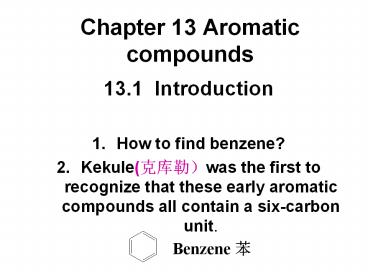Chapter 13 Aromatic compounds - PowerPoint PPT Presentation
1 / 53
Title:
Chapter 13 Aromatic compounds
Description:
The nitrogen atoms in molecules of both pyridine and pyrrole are sp2 hybridized. 13.17 The orbital structures of furan and thiophene 13.13 Aromatic compounds in ... – PowerPoint PPT presentation
Number of Views:465
Avg rating:3.0/5.0
Title: Chapter 13 Aromatic compounds
1
Chapter 13 Aromatic compounds
- 13.1 Introduction
- How to find benzene?
- Kekule(???)was the first to recognize that these
early aromatic compounds all contain a six-carbon
unit.
Benzene ?
2
13.2 Nomenclature of benzene Derivatives
3
(No Transcript)
4
Monosubstituted benzenes
5
When two substituents are present, their relative
positions are indicated by the prefixes ortho,
meta, and para (abbreviated o-, m-, and p-) or by
the use of numbers.
6
Nitrobenzoic acids ?????
7
The dimethylbenzenes are called xylenes (???)
8
If more than two groups are present on the
benzene ring, their positions must be indicated
by the use of numbers.
9
The new parent name is used
10
When the C6H5- group is named as a substituent,
it is called a phenyl group (ph-).
11
The phenyl group is often abbreviated as C6H5-,
Ph-.The name benzyl is an alternative name for
the phenylmethyl group
12
13.3 Reactions of benzene
13
13.4 The Kekule Structure for benzene ???????
- In 1865,Kekule, the originator of the structural
theory, proposed the first definite structure for
benzene, a structure that is still used today.
Kekule suggested that the carbon atoms of benzene
are in a ring, that they are bonded to each other
by alternating single and double bonds, that one
hydrogen atom is attach to each carbon atom.
14
The Kekule formula for benzene??????
15
(No Transcript)
16
13.5 The stability of benzene?????
17
Fig. Relative stabilities ?????
18
13.6 Modern theories of the structure of benzene
- 13.6A the resonance explanation of the structure
of benzene (???????????)
19
13.6B The molecular orbital explanation of the
structure of benzene (????????????)
20
Fig. 13.3 Overlapping p orbitals in benzene
(??p?????)
21
Fig. 13.4 How six p atomic orbital combine to
form six pi- molecular orbitals
22
Fig. 13.5 Shapes of the pi-molecular orbitals of
benzene as viewed from down
23
13.7 HUCKELS Rule(?????) The (4n2)
pi-Electron Rule
- Conditions
- The (4n2) pi-electron,where n1,2,3---
- Planar monocyclic ring conjugate system
(????????) - ??????????????(Aromatic), ????????,???????????????
,????
24
For example
25
13.7A The Annulenes (??)
- The name annulene has been proposed as a general
name for monocyclic compounds that can be
represented by structures having alternating
single and double bonds.
26
(No Transcript)
27
(No Transcript)
28
Cyclobutadiene is a 4n molecule not a 4n2
molecule, and as we would expect, it is a highly
unstable compound and it is not aromatic.
29
13.7B Aromatic Ions ????
- Cyclopentadiene is not aromatic however, it is
unusually acidic for a hydrocarbon. Because of
its acidity, cyclopentadiene can be converted to
its anion by treatment with moderately strong
bases.
30
(No Transcript)
31
Cycloheptatriene (????)
32
13.8 Other aromatic compounds
- 13.8A benzenoid aromatic compounds (???????)
- Representatives of one broad class of aromatic
compounds called polycyclic benzenoid aromatic
hydrocarbons.
33
(No Transcript)
34
According to resonance theory, a molecule of
naphthalene can be considered to be a hybrid of
three Kekule structure.
35
Fig. 13.2 The p orbitals of naphthalene
36
(No Transcript)
37
13.8B Nonbenzenoid aromatic compounds??????????
38
13.9 Reduction of aromatic compounds The Birch
reduction ????
39
13.9A The Birch reduction ????
- Benzene can be reduced to 1,4-cyclohexadiene by
treating it with an alkali metal(sodium (Na),
lithium (Li), or potassium (K)) in a mixture of
liquid ammonia and alcohol.
40
The Mechanism of Birch reduction ???????
41
Dissolving metal reductions of this type were
developed by the Australian chemist A.J. Birch
and have come to be known as Birch reductions
42
Reduction of 1,2-dimethylbenzene (o-xylene ?-???)
43
Birch reduction of sodium benzoate
44
13.10 Benzylic radicals and cations
- Removal of a hydrogen atom from the methyl group
of methylbenzene (Toluene) produces a radical
called the benzyl radical (?????)
Benzylic radicals and benzylic cations are
conjugated unsaturated systems and both are
stable.
45
This exceptional stability of benzylic radicals
and cations is easily explained by resonance
theory.
46
Benzylic cations are stabilized by resonance
47
13.11 Allylic and benzylic halides in
nucleophilic substitution reactions
(????????????????)(??)
48
13.12 Heterocyclic aromatic compounds (????????)
- Heterocyclic compounds containing nitrogen,
oxygen, or sulfur are by far the most common.
Four important examples are given here in their
KeKule forms. These four compounds are all
aromatic.
49
The nitrogen atoms in molecules of both pyridine
and pyrrole are sp2 hybridized.
50
13.17 The orbital structures of furan and
thiophene
The oxygen and sulfur atoms of furan and
thiophene carry an Unshared pair of electrons in
an sp2 orbital that is orthogonal to the
psystem.
51
13.13 Aromatic compounds in biochemistry
- Two amino acids necessary for protein synthesis
contain the benzene ring
52
(No Transcript)
53
Homework P 548Additional Problems13.22,
13.23, 13.28































